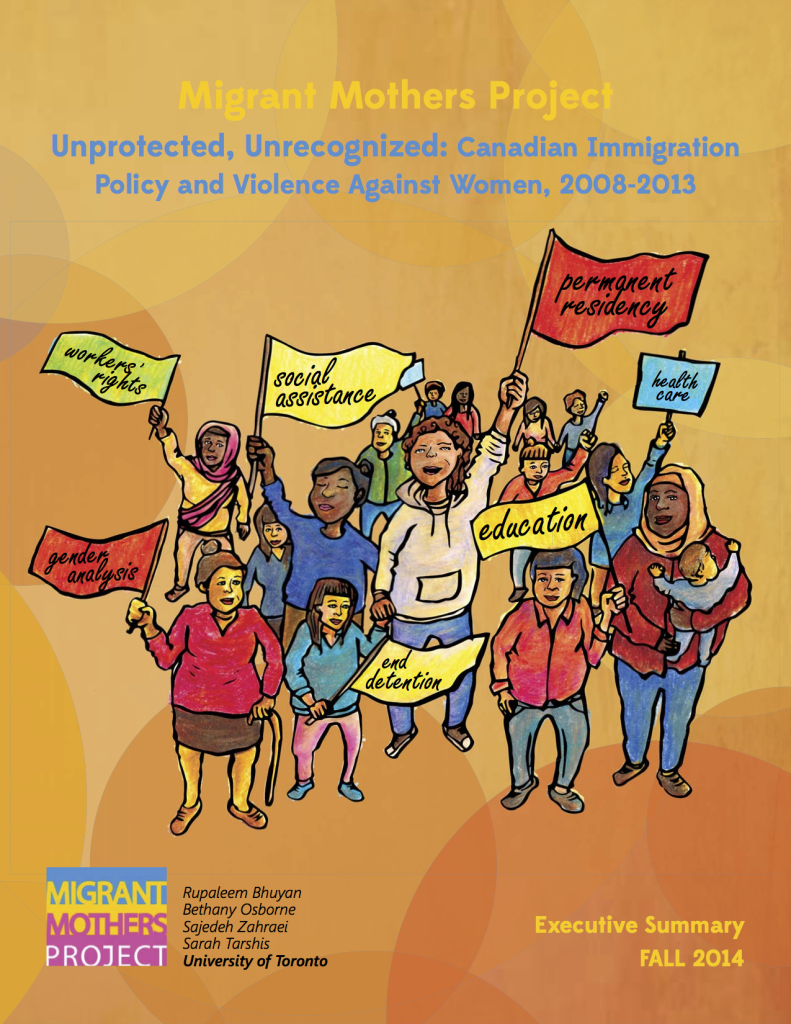Unprotected, Unrecognized: Canadian Immigration Policy and Violence Against Women, 2008-2013
By: Rupaleem Bhuyan, Bethany Osborne, Sajedeh Zahraei, and Sarah Tarshis
Migrant Mothers Project, University of Toronto
- Download the Executive Summary: MMP Policy Report_Exec Summary Nov 14 2014
- Download the Full Report: MMP Policy Report Final Nov 14 2014
Executive Summary
In 2013, The Migrant Mothers Project conducted research to understand how immigration and refugee policies impact the safety of immigrants who have precarious status. Since 2008, the Canadian government has introduced an unprecedented number of legislative and regulatory changes that have impacted immigrants’ and refugees’ access to legal representation, access to social and health services, and pathways to permanent residence. We wanted to understand how immigration policy changes are impacting how community based organizations work with women and precarious immigration status, especially in cases where women are seeking safety from violence.
Over the past two decades, anti-violence against women advocates have grappled with intersecting oppressions that impact women’s efforts to flee or recover from violence. When Linda Macleod and Maria Shin were commissioned by Health Canada to study the service delivery needs of immigrant and refugee women, they emphasized that many immigrants and refugees who were abused are isolated due to language and cultural barriers, racism, the ‘strangeness’ of their environment and the power that their immigration sponsors held over them. Supporting refugee claimants, immigrants who were facing sponsorship breakdown, and developing programs, to address language barriers, ethno-cultural differences, and queer and trans people in immigrant communities emerged as key concerns in anti-violence against women programs and services. More recently organizations have identified immigration status as a pivotal factor that increases vulnerability to abuse and neglect.
The primary goals of this report are to:
- Develop a framework for understanding precarious immigration as part of the spectrum of violence against women (VAW)
- Identify how recent immigration policies are impacting women’s rights and safety
- Illustrate case examples of individual, community and policy advocacy taking place across Canada.
This report focuses on immigration and refugee policies that were introduced between 2008-2013, a period that has been described as the most active in Canadian immigration policy development since the country’s inception. This rapid pace of policy development has taken place without meaningful consultation from anti-violence against women service providers and community organizations. We join the call for a National Action Plan on Violence Against Women, as put forward by the Network of Women’s Shelters and Transition Houses (2013) that adheres to guidelines set out in the U.N. Convention on the Elimination of All Forms of Discrimination against Women and the U.N. Declaration on the Elimination of Violence Against Women.
We extend our gratitude to women living with precarious immigration status, who contributed to this report through partaking in interviews, community events, and membership on the project’s advisory board. We are also grateful for the lively discussions and dialogues among immigrant women, social and health service providers, grassroots activists, lawyers and educators, whose knowledges and wisdom inspired this report.
We hope this report contributes to ongoing dialogue and critical assessment of Canadian laws and policies towards upholding the rights of immigrant and refugee women to live free from violence.
Citation
Bhuyan, R., Osborne, B., Zahraei, S. and Tarshis, S. (2014). Unprotected, Unrecognized: Canadian Immigration Policy and Violence Against Women, 2008-2013. Toronto, Ontario: Migrant Mothers Project, University of Toronto.